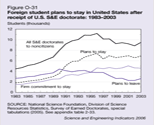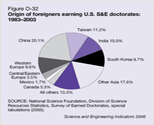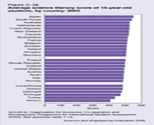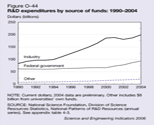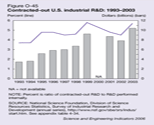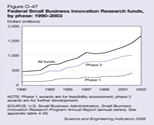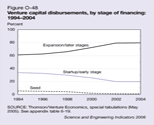![]() Print this chapter (1.5MB)
Print this chapter (1.5MB)
S&E Trends in the United States
 The U.S. S&E Labor Force
The U.S. S&E Labor Force U.S. Academic R&D
U.S. Academic R&D Doctoral Scientists and Engineers in Academia
Doctoral Scientists and Engineers in Academia Broader U.S. R&D Trends
Broader U.S. R&D Trends
The U.S. S&E Labor Force
S&E jobs play a growing role in the U.S. economy, but U.S. S&E degree production lagged growth in S&E occupations.
In 2003, the number of people working in S&E occupations reached 4.6 million, up from 3.3 million a decade earlier. The past decade's growth in S&E jobs continues a longer trend. In each of the past five decades, S&E jobs in the U.S. economy grew more rapidly than the overall civilian labor force. After unusually rapid increases in the 1950s (averaging about 17%), S&E employment through the 1990s rose at an annual average of 3.5%, more than three times as fast as the growth in overall civilian employment (figure ![]() ). In 2003, another 8.6 million holders of S&E degrees worked in jobs not classified as S&E, up from 6.5 million a decade earlier. Many of these other jobs required some S&E knowledge, indicating an increase in these jobs' technical content.
). In 2003, another 8.6 million holders of S&E degrees worked in jobs not classified as S&E, up from 6.5 million a decade earlier. Many of these other jobs required some S&E knowledge, indicating an increase in these jobs' technical content.
S&E degree production increased but was less than the 4% average annual growth rate of S&E employment from 1980 to 2000. The more rapid expansion of S&E jobs was made possible by the growing numbers of foreigners who earned U.S. degrees and subsequently stayed in the country, those with foreign S&E degrees who migrated to the United States for a limited period or permanently, and low retirement rates of scientists and engineers who, as a group, were younger than the overall labor force.
The influx of scientists and engineers from Asia and elsewhere accelerated in the 1990s.
The 1990s showed strong increases in the number of foreign-born individuals holding U.S. S&E jobs; by 2000, this share had increased from 14% to 22% (figure ![]() ). The largest increases were for doctorate holders, from 24% to 38%, and for certain job specialties. More than half of the engineers holding doctorates and 45% of doctorate holders in the physical sciences, computer sciences, and life sciences were foreign born. One-third of these foreign-born scientists and engineers came from India, China, and the Philippines; among doctorate holders, those from China and India alone comprised one-third of the total.
). The largest increases were for doctorate holders, from 24% to 38%, and for certain job specialties. More than half of the engineers holding doctorates and 45% of doctorate holders in the physical sciences, computer sciences, and life sciences were foreign born. One-third of these foreign-born scientists and engineers came from India, China, and the Philippines; among doctorate holders, those from China and India alone comprised one-third of the total.
Foreign students earned one-third of U.S. S&E doctorates and 55% of engineering doctorates, whereas doctorates earned by U.S. white males dropped sharply.
The production of U.S. S&E doctorates since 1990 has been robust, rising from 23,800 to a record 28,800 in 1998 before dropping to 26,900 in 2003. The overall number depended heavily on foreign students. Students holding temporary visas earned between 6,800 and 8,700 doctorates a year (figure ![]() )—in 2003 they earned one-third of the total number of doctorates, more than half of those in engineering, 44% of those in mathematics and computer science, and 35% of those in the physical sciences. The number of U.S. Asian students is inflated by the conversion of large numbers of Chinese students with temporary visas to permanent status under the 1992 Chinese Student Protection Act.
)—in 2003 they earned one-third of the total number of doctorates, more than half of those in engineering, 44% of those in mathematics and computer science, and 35% of those in the physical sciences. The number of U.S. Asian students is inflated by the conversion of large numbers of Chinese students with temporary visas to permanent status under the 1992 Chinese Student Protection Act.
Large numbers of foreign doctorate holders continue to stay in the U.S. after receiving their degree.
Recent downturns in foreign enrollment notwithstanding, many foreign students pursue advanced study in S&E fields at U.S. universities. These students frequently choose to stay in the United States after earning their S&E degree. Beginning in the 1990s, a growing number of graduate students, doctorate holders, and postdoctoral fellows chose to remain in the country for further study or work. Since the mid-1990s, every year about 6,500–7,000 foreign students who earned a U.S. S&E doctorate planned to stay in the United States after receiving their degree (figure ![]() ). Through 2003, many of these students remained in the country for years after graduation: 53% of the 1993 doctorate recipients were working in the United States in 1997 and 61% of the 1998 cohort remained in the country in 2003. However, increasing international competition for foreign students raises questions about the continued viability of these high rates.
). Through 2003, many of these students remained in the country for years after graduation: 53% of the 1993 doctorate recipients were working in the United States in 1997 and 61% of the 1998 cohort remained in the country in 2003. However, increasing international competition for foreign students raises questions about the continued viability of these high rates.
Asian locations that have been the source of two-thirds of foreign doctoral candidates in the United States are developing their own S&T infrastructures.
During the past two decades, two-thirds of foreign students earning a U.S. S&E doctorate were from Asia: about 20% from China and 10%–11% each from Taiwan, India, and South Korea (figure ![]() ). However, Asia is investing heavily in the development of knowledge-based economies and higher education systems, and countries such as Japan are starting to import large numbers of Asian scientists and engineers. Thus, there is no assurance of a continued influx of students from this region to the United States, especially since other countries are creating immigrant-friendly policies for those with advanced S&E degrees.
). However, Asia is investing heavily in the development of knowledge-based economies and higher education systems, and countries such as Japan are starting to import large numbers of Asian scientists and engineers. Thus, there is no assurance of a continued influx of students from this region to the United States, especially since other countries are creating immigrant-friendly policies for those with advanced S&E degrees.
Foreign student visas are recovering but remain down by one-fifth since 2001, and other high-skill visa categories are trending upward.
The U.S. reaction to the events of September 11, 2001, affected the flow of foreign-born scientists and engineers into the United States. The number of student, exchange visitor, and other high-skill-related visas issued annually grew rapidly during the 1990s but decreased sharply after September 11. The number of applications declined because of increased difficulty in processing, higher cost, and heightened scrutiny of applicants. The number of visas issued reached a low point in 2003 and has since recovered. By 2005, the number of student visas issued had risen to their 2002 level, as the length of time for processing along with the difficulty in processing had decreased. The number of student visas issued remained below the 2001 level, while that for exchange visitors exceeded it. (figure ![]() ).
).
A leading indicator suggests declining foreign enrollments in advanced S&E study.
First-time, full-time enrollment in graduate study, a leading indicator, shows significant changes since 2001. The number of foreign students enrolling for the first time dropped sharply in 2003 compared with the 2001 level (figure ![]() ). The 2-year decline was most pronounced in mathematics and computer science (–28%) and engineering (–17%), fields heavily favored by foreign students. Gains by U.S. citizens and permanent visa holders more than off-set these losses, with both engineering and mathematics and computer science rising by about 40%. However, these trends may be about to change again; data compiled by the Institute of International Education show an increase of about 2.4% in foreign graduate enrollment from 2003 to 2004.
). The 2-year decline was most pronounced in mathematics and computer science (–28%) and engineering (–17%), fields heavily favored by foreign students. Gains by U.S. citizens and permanent visa holders more than off-set these losses, with both engineering and mathematics and computer science rising by about 40%. However, these trends may be about to change again; data compiled by the Institute of International Education show an increase of about 2.4% in foreign graduate enrollment from 2003 to 2004.
Many retirements from the U.S. S&E labor force are impending.
Barring major changes in current trends, many individuals in the S&E labor force will retire in the coming decades. In 2003, 13% of S&E bachelor's degree holders, 20% of master's degree holders, and 28% of doctorate holders were 55 years old or older (figure ![]() ). Historically, by age 61 about half of the bachelor's degree holders no longer work full time; the same is true at age 62 for those with master's degrees and at age 64 for doctorate holders.
). Historically, by age 61 about half of the bachelor's degree holders no longer work full time; the same is true at age 62 for those with master's degrees and at age 64 for doctorate holders.
Women and minorities earned increased shares of S&E degrees, including advanced degrees.
Among U.S. citizens and those who hold permanent visas, women and members of minority groups increased their share of S&E degrees at the bachelor's and higher degree levels. Beginning in 2000, women received half of these degrees, Asians received 10%, and other minorities received 18% (figure ![]() ). The number of S&E undergraduate degrees was 416,000 in 2002, the last year for which data are available. Three major trends since 1990 are a strong increase in the social sciences and psychology, a sustained rise in life sciences followed by a gradual decline, and steep growth in computer science degrees beginning in the late 1990s.
). The number of S&E undergraduate degrees was 416,000 in 2002, the last year for which data are available. Three major trends since 1990 are a strong increase in the social sciences and psychology, a sustained rise in life sciences followed by a gradual decline, and steep growth in computer science degrees beginning in the late 1990s.
Continuing demographic changes in college-age cohorts pose challenges to raising domestic S&E degree output.
Projected changes in the composition of successive U.S. college-age cohorts will present challenges to increasing the number of S&E degrees earned by U.S. citizens. The share of whites is projected to decline from 71% in 1990 to 58% by 2020; historically whites have been more likely than other groups (except Asians) to earn S&E degrees. The share of Asians is projected to increase to 6%. The Hispanic share will nearly double (from 12% to 22%), while the shares of blacks and other minorities will remain flat, at a combined total of about 15% (figure ![]() ).
).
The performance of U.S. students in elementary and secondary schools may raise concerns.
International and domestic assessments of the performance of American students present a mixed picture. Both U.S. fourth and eighth grade students scored above the international average on the 2003 Trends in International Math and Science Study (TIMSS), which measures mastery of curriculum-based knowledge and skills. TIMSS calculated the average of all participating countries, both developed and developing. However, U.S. 15-year-olds scored below the international average on the 2003 Programme for International Student Assessment (PISA), which measures students' ability to apply scientific and mathematical concepts and skills (figure ![]() ). OECD administers PISA, and PISA's average was based on scores from industrialized OECD countries only. In the United States, only about one-third of 4th and 8th grade students and less than 20% of 12th graders reached proficiency in mathematics and science tests administered by the National Assessment of Educational Progress; scores for underrepresented minorities were significantly lower. Proficiency in these tests denotes solid performance for the students' grade based on judgments of what students should know and be able to do in the subject assessed.
). OECD administers PISA, and PISA's average was based on scores from industrialized OECD countries only. In the United States, only about one-third of 4th and 8th grade students and less than 20% of 12th graders reached proficiency in mathematics and science tests administered by the National Assessment of Educational Progress; scores for underrepresented minorities were significantly lower. Proficiency in these tests denotes solid performance for the students' grade based on judgments of what students should know and be able to do in the subject assessed.
In sum, prospects for the U.S. S&E workforce are for slower growth, rising retirements, and increasing average age.
Taken together, and barring significant changes, current trends in degree production, retirement, and immigration suggest that the number of trained scientists and engineers in the labor force will continue to increase, but at a slower rate; the average age of S&E workers will rise; and the number of retirements will increase sharply over the next two decades. Declining degree production or immigration would accentuate these trends.
U.S. Academic R&D
Since 1990, inflation-adjusted academic R&D expenditures have almost doubled, driven by federal and institutional funds.
Expenditures for academic R&D reached $40 billion in 2003, the second-fastest growth of any U.S. R&D sector. The federal government supplied 62% of these funds, up from 59% in 1990, reversing the long-declining share of federal dollars. The universities themselves provided an additional 19%. State government and industry support grew slowly, state government funding because of unfavorable budget conditions, industry funding because of retrenchment after the collapse of the dot.com industry (figure ![]() ). The life sciences share of academic research expenditures rose to 59%, whereas the shares of engineering and the physical sciences declined because their funding grew more slowly.
). The life sciences share of academic research expenditures rose to 59%, whereas the shares of engineering and the physical sciences declined because their funding grew more slowly.
Academic laboratory construction is booming, but equipment spending is at a long-term low.
Extensive laboratory construction activities are currently under way; in 2002–03, almost half of all universities began construction projects. Investment for new laboratory space stood at $7.6 billion in 2003, with another $9.1 billion in projects scheduled to start in 2004 or 2005. Most of these expenditures were for the biological and life sciences (58%–60%) and engineering (14%). During most of the period, state and local governments supplied about one-third of the funds (and more in the mid-1990s); the federal government's share was 5% in 2002–03, reflecting the growing prominence of institutional sources, private donations, and forms of debt funding. Cutting-edge research also requires state-of-the-art research equipment. However, equipment spending, generally from operating funds, grew more slowly than overall research funds and reached a long-term low of 4.5% of academic R&D expenditures in 2003 (figure ![]() ).
).
Doctoral Scientists and Engineers in Academia
Fewer S&E doctorate holders are employed in academia, and fewer have traditional faculty positions, especially among young doctorate holders.
The academic doctoral labor force grew from 211,000 in 1991 to 258,000 in 2003, representing fewer than half of all employed S&E doctorate holders. In academia, the share of those with full-time faculty appointments declined from 82% to 75%. The share of full-time senior faculty fell below 55% in 2003, and the share of junior faculty was about 20%. These trends were accentuated for those with recent doctorates (figure ![]() ).
).
The academic doctoral labor force has become more diverse with the employment of more women, minority group members, and those born in other countries.
Increased conferral of S&E degrees to women and minority group members has been accompanied by rising academic employment among these groups. In 2003, women constituted 30% of all academic positions and 28% of full-time faculty. At a level of 8% in 2003, blacks, Hispanics, and American Indian/Alaska Natives remained a small proportion of total academic employment. The growing number of foreign-born doctorate holders in the academic labor force cannot be accurately determined from available data. Of those with U.S. degrees who are employed in academia, increasing proportions have been foreign born, rising from 17% in 1989 to 23% in 2003 (figure ![]() ).
).
The number of academic researchers is growing, but government support, despite strong growth, reaches fewer of them, especially those at the start of their careers.
The numbers of individuals with primary work responsibility for R&D increased more rapidly than those with primary teaching responsibility. Academic researchers rely on the federal government for a significant share of their support. In 2003, 46% of all academic doctoral scientists and engineers and 72% of those for whom research was their primary work activity received federal support. These figures are less than those for the late 1980s and early 1990s for all fields except engineering, and the differences over time are especially pronounced for those with recent doctorates who are trying to establish a career (figure ![]() ).
).
Broader U.S. R&D Trends
Total U.S. R&D performance rebounded robustly after declining in 2002.
Total U.S. R&D expenditures more than doubled since 1990 and are projected to reach $313 billion in 2004. This strong rebound follows the first-ever reduction in 2002 that was caused by industry's retrenchment after the collapse of the dot.com industry. Adjusting for inflation, the 1990–2004 increase was 55%, with strong post-2002 gains in both federal and industry support. However, industry's share of total R&D support dropped from 70% in 2000 to 64% in 2004 as federal R&D investment rose, especially in security-related areas (figure ![]() ).
).
R&D performance in concert with external partners is increasing.
Firms are increasingly collaborating with external partners to conduct R&D in response to the growing complexity of R&D activities and the desire to reduce risks, share costs, expedite projects, complement internal capabilities, and enter new markets. This collaboration takes many forms, e.g., contracting out R&D and forming formal strategic alliances. In 2003, U.S. firms contracted $10.4 billion worth of R&D to other performers, up from less than $2 billion a decade earlier. This amounted to nearly 6% of internally performed R&D, up from less than 4% in 1993 (figure ![]() ). From 1993 to 2003, contracted R&D grew twice as fast as in-house R&D, and for manufacturing companies it grew nearly three times as fast.
). From 1993 to 2003, contracted R&D grew twice as fast as in-house R&D, and for manufacturing companies it grew nearly three times as fast.
Every year, many U.S. companies enter into formal strategic technology alliances domestically or with companies in other countries. With some year-to-year variation, about half of these alliances tend to be among U.S. partners only, with the other half primarily focusing on Europe. Formation of alliances increased rapidly during the early 1990s, peaked in 1995, and recently started increasing again. In 2003, U.S. companies announced nearly 500 new strategic alliances; 220 of them were among U.S. firms (figure ![]() ).
).
Federal stimulation of small business innovation is increasing.
A fixed portion of federal agencies' extramural R&D funds is set aside for competitive awards to small businesses to commercialize the results of federally funded projects. Small (Phase I) awards of short duration are designed to assess the scientific and technical feasibility of ideas with commercial potential; Phase II awards are intended for further development. Subsequently, the innovation must be brought to market with private-sector investment but without further federal support. Total funds awarded under this program have increased from about $500 million in the early 1990s to just under $1.7 billion in 2003 (figure ![]() ). The number of awards has nearly doubled, to just under 6,000.
). The number of awards has nearly doubled, to just under 6,000.
U.S. venture capital, the seedbed of startup companies, grows risk-averse.
At $21 billion, U.S. venture capital disbursements have again reached the level of the late 1990s after the collapse of the dot.com industry, but startup capital is scarcer than ever. The focus has shifted to expansion and later-stages funding, which consumed 80% of the funds disbursed in 2004. Startup and other early-stage funding dropped from 34% of funds in the early 1990s to 20%. Seed funding, the earliest stage with the most risk, received only $158 million, its lowest level since the early 1990s; this figure represented 0.8% of disbursed funds in 2004 compared with 5% through the mid-1990s (figure ![]() ). With the end of the surge in the dot.com industry, funds have shifted from Internet-specific firms to software and medical and health companies.
). With the end of the surge in the dot.com industry, funds have shifted from Internet-specific firms to software and medical and health companies.




